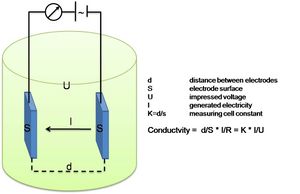Difference between revisions of "Template:This weeks featured article"
| Line 2: | Line 2: | ||
[[Image: electrode_conductivity.JPG | 300px| thumb |right| Electrode Conductivity principle]] | [[Image: electrode_conductivity.JPG | 300px| thumb |right| Electrode Conductivity principle]] | ||
Since as far as Ancient Greece times, attempts have been made to try to measure the "saltiness" of seawater. However, methods' efficiency was very incipient and their sensitivity and repeatability was very limited. During the Modern History more precise methodologies were developed: weighing after evaporation (Boyle,1693; Birch, 1965), solvent extraction (Lavoisier, 1772) and precipitation (Bergman, 1784). | Since as far as Ancient Greece times, attempts have been made to try to measure the "saltiness" of seawater. However, methods' efficiency was very incipient and their sensitivity and repeatability was very limited. During the Modern History more precise methodologies were developed: weighing after evaporation (Boyle,1693; Birch, 1965), solvent extraction (Lavoisier, 1772) and precipitation (Bergman, 1784). | ||
| − | In 1865, Forchhammer introduced the term salinity and dedicated himself to measure individual components of seasalt rather than the total salinity. He found that the ratio of major salts in samples of seawater from various locations was constant | + | In 1865, Forchhammer introduced the term salinity and dedicated himself to measure individual components of seasalt rather than the total salinity. He found that the ratio of major salts in samples of seawater from various locations was constant. |
Salinity is a ratio and not a physical parameter that can be measured(under PSS-78, see box). Thus, “Salinity sensors” do not exist. What is commonly referred to as a salinity sensor is in fact a conductivity sensor. | Salinity is a ratio and not a physical parameter that can be measured(under PSS-78, see box). Thus, “Salinity sensors” do not exist. What is commonly referred to as a salinity sensor is in fact a conductivity sensor. | ||
Revision as of 14:59, 2 July 2013
Salinity sensors
Since as far as Ancient Greece times, attempts have been made to try to measure the "saltiness" of seawater. However, methods' efficiency was very incipient and their sensitivity and repeatability was very limited. During the Modern History more precise methodologies were developed: weighing after evaporation (Boyle,1693; Birch, 1965), solvent extraction (Lavoisier, 1772) and precipitation (Bergman, 1784). In 1865, Forchhammer introduced the term salinity and dedicated himself to measure individual components of seasalt rather than the total salinity. He found that the ratio of major salts in samples of seawater from various locations was constant.
Salinity is a ratio and not a physical parameter that can be measured(under PSS-78, see box). Thus, “Salinity sensors” do not exist. What is commonly referred to as a salinity sensor is in fact a conductivity sensor.
